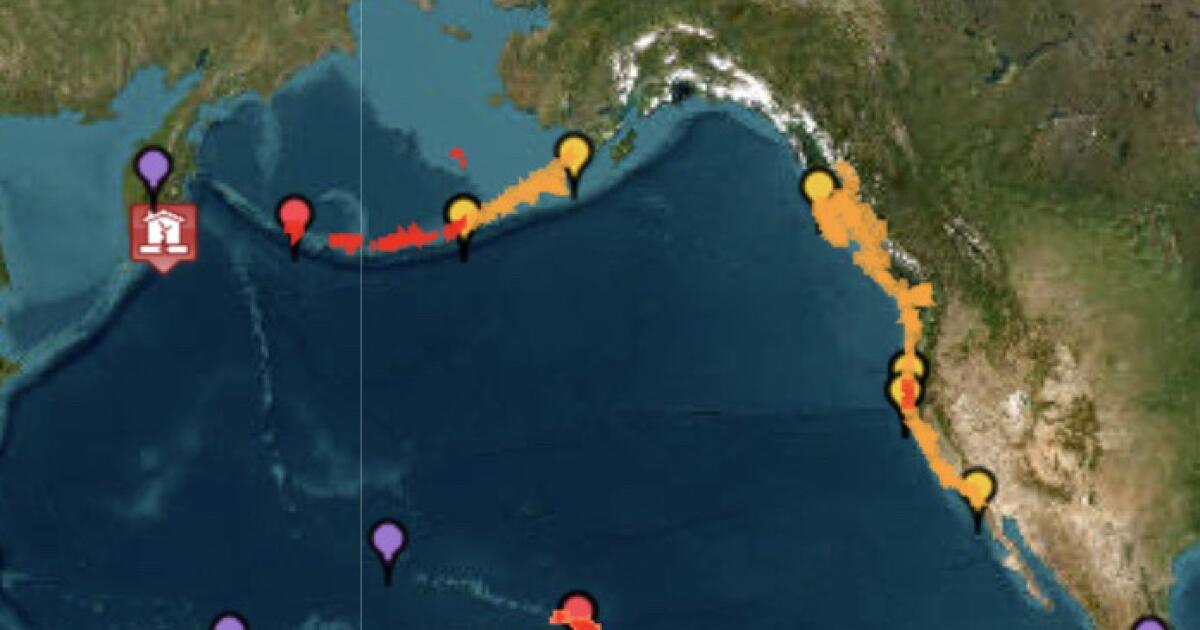Officials upgraded a tsunami alert for California’s North Coast, issuing a more severe “warning” in Humboldt and Del Norte counties, with the worst potential damage predicted in Crescent City, a historical tsunami hot spot.
A tsunami warning is the top level of the U.S. Tsunami Warning Center three-tier alert system — watch, advisory and warning — and means that residents are urged to move away from the coast immediately. A warning was also in place across all of Hawaii, where residents rushed to evacuate inland, as well as in Guam and along the western section of Alaska’s Aleutian Islands.
The rest of the California coast remains under a tsunami advisory, meaning that strong strong currents and dangerous waves are expected and that people should stay off of beaches.
Should a tsunami materialize in California, it would hit the North Coast at 11:50 p.m. and, by 1 a.m., reach the Los Angeles area. The impact in L.A. is predicted to be much smaller, with waves of less than 1 foot, according to the warning center.
The tsunami could last as long as 30 hours in Crescent City, where waves of up to 4.8 feet are predicted. Crescent City’s harbor was destroyed and one man died in a 2011 tsunami, which was generated from a 9.1 magnitude earthquake off the east coast of Japan.
Another area that could see significant tsunami is Port San Luis in San Luis Obispo County, where a tsunami of 2 to 3.7 feet could hit. Waves of 1.3 feet and under were predicted for the rest of the California coastline.
Tsunami hazard zones can extend to bayside and riverside areas relatively far from the Pacific coast.
Zoom in and move the map to see the state’s tsunami hazard areas
Tsunami alerts were issued Tuesday afternoon after an 8.8 magnitude earthquake struck off the eastern coast of Russia, sending powerful waves slamming into buildings in Siberia and northeastern Japan.
According to the U.S. Tsunami Warning Center, alerts are in effect for the entire West Coast, including Washington and Oregon, as well as portions of British Columbia and Alaska.
The earthquake struck off of the eastern coast of Russia’s Kamchatka Peninsula in eastern Siberia at 9:25 a.m. Wednesday local Russian time — which is 4:25 p.m. Tuesday PDT — generating strong tremors that injured several people, according to reporting by Reuters.
A tsunami of 10 to 13 feet hit the Kamchatka Peninsula in Siberia within hours of the earthquake, damaging buildings, including a kindergarten, according to Reuters. Japanese officials advised people to evacuate tsunami-prone areas along the country’s east coast, warning that waves of up to 10 feet could strike the coastline.
Hawaii News Now reported congested roadways as people heeded evacuation plans, and some were seen stocking up at Costco ahead of the expected arrival of the tsunami, which could come as early as 7:17 p.m. local time, or 10:17 p.m. PDT. Southwest rerouted a flight from LAX to Honolulu, returning to LAX due to the tsunami warning.
“Right now, we’re traumatized,” Dominga Advincula, a longtime resident of the foothill neighborhood where the Lahaina blaze ignited, told The Times. “Every hour, they make the sound of sirens for everybody to leave the ocean and it makes us traumatized again for what happened in 2023.”
She’d been sent home from her job at a Kaanapali hotel after the warnings blared. Nearby roads were crowded with people trying to get to higher ground, she said.
One of the first tsunami reports came in Hokkaido, Japan, where the Nemuro Hanasaki port experienced a 1-foot tsunami, according to NHK, the Japanese broadcaster. NHK footage showed buildings that appeared to be warehouses being swept away by strong tsunami currents in northeastern Japan.
The Tsunami Warning Center had initially issued a lower-tier tsunami watch for the West Coast of the U.S. earlier Tuesday afternoon. The upgraded tsunami advisory alert was sent out around 6:30 p.m, then the even more severe warning for the North Coast was issued around 9 p.m.
Potential waves would hit Fort Bragg in Mendocino County at 11:50 p.m. Tuesday and Crescent City in Del Norte County at 11:55 p.m.
Then, in the early hours of Wednesday morning, potential waves would reach Monterey at 12:15 a.m., San Francisco at 12:40 a.m. Wednesday, the Los Angeles harbor at 1:05 a.m., Newport Beach at 1:10 a.m., and Oceanside and La Jolla at 1:15 a.m.
Officials warned that the first tsunami wave might not be the largest. In fact, the first tsunami wave usually is not the highest one, and tsunamis can last for hours.
In the devastating tsunami of 1964 that hit Crescent City, people were lulled into a false sense of security after a series of smaller waves, and some had returned to start cleaning up when the fourth wave hit. Surges as high as 21 feet above the average low tide smashed the city, washing away 29 city blocks and killing at least 11 people.
Officials warn that tsunami waves that seem relatively small — like 6 inches in height — can be destructive.
It only takes six inches of fast-moving water to knock over an adult and two feet of fast-moving water to carry away most vehicles.
“Strong currents can injure and drown people in or near the water and damage and destroy boats and infrastructure in harbors,” the National Tsunami Hazard Mitigation Program says.
L.A. Mayor Karen Bass said she was in touch with coastal leaders and the Port of L.A. about overnight preparations and urged residents to sign up for emergency alerts at NotifyLA.org.
San Francisco officials said they were “working together to evaluate whether the evacuation of shoreline areas is necessary, and will send out additional alerts as soon as possible.”
